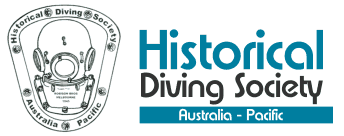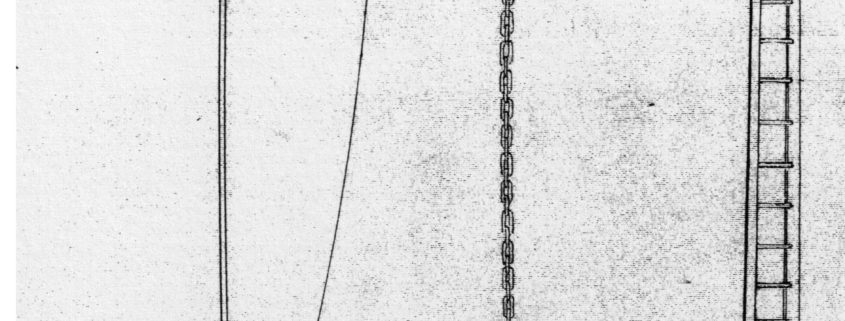Helmet Diving in Australia – The Earliest Record
by Des Williams – HDS Aus-Pac
When was helmet diving first employed in Australia? This is a question we often get asked at the Historical Diving Society and one which we are now able to answer with some certainty, following our detailed historical research.
Dr. John Bevan, Chairman of HDS UK, has conducted thorough research into the development of helmet diving around the world, which began in the UK in the late 1820s. Brothers Charles and John Deane are credited with having developed the diving helmet, after adapting Charles’s fire-fighting smoke helmet, for underwater use. Initially, the helmet was used in an “open helmet” format with a canvas jacket attached to the helmet allowing air to bubble out around the hem of the jacket, at the diver’s chest level. It was not unlike diving in an inverted bucket! Several years passed before the “closed dress”, a one-piece waterproof canvas suit, was developed and secured to the lower edge of the helmet (corselet) to keep the diver totally dry.
Deane used his diving kit to complete some remarkable feats of salvage and contemporary Australian newspapers of the 1800s often reported on his successes overseas, especially during the 1830s. British newspapers syndicated their news to early Australian papers, so colonial Australian’s were well aware of Deane’s achievements and derring-do overseas.
In 1836, Charles Deane presented his “Submarine Exhibition” in London, featuring his diving apparatus and a display of some of the valuable relics he had recovered from wrecks around the British coast, mostly under contract to the Royal Navy. He also produced a small pamphlet for distribution at the exhibition, detailing his Patented diving apparatus, with the intention of generating world-wide sales of his equipment. It was a very successful exhibition.
In 2009, Dr. John Bevan attempted to put together a Timeline for the spread of the Deane apparatus around the world and in it Australia was listed as the 13th country to adopt the system. John is the first to admit that his Timeline stands open for correction and improvement as researchers around the world find documented proof of Deane’s apparatus being used and he enthusiastically welcomes correspondence from researchers in this regard.
So, it was with some surprise and much delight that this author came across a very nice reference to Mr. Deane’s helmet gear being imported to Sydney in 1837! Yes, this fact effectively moves Australia up to share 3rd position, along with the USA on John Bevan’s Deane Timeline.
It seems that Captain Fotheringham, a Sydney sea captain and business man, may have been one of the colonials to pay a visit to Deane’s 1836 London exhibition and place an order for the apparatus to compliment his growing dockyard and slipway facility in Cockle Bay Sydney. The following two contemporary newspaper references should give a clear picture of what was going on in bustling colonial Sydney Town at in the 1830s.
From The Sydney Herald (1831-1842) 27th May 1833 page 3
“Captain Fotheringhame’s (sic) patent slip in Cockle Bay is now completed, and it is said that at eleven o’clock this morning, the barque Tamar will be hauled upon it, to show its efficacy. On which occasion, His Excellency has intimated his intention of being present to witness the experiment.”
And from The Sydney Morning Herald Monday 31st July 1837 page 2
“Captain Fotheringham has imported by the Achilles a diving apparatus of the same description as that in which the Patentee (Mr Dean) remained under water for five hours and forty minutes and recovered from the wrecks of the Royal George the Mary Rose (the latter sunk in 1544) and other vessels, property to a considerable amount.”
And just one month later, in August 1837, we find this fascinating article which provides the earliest documented confirmation so far, of the use of a helmet diving system in Australia.
From The Sydney Gazette and New South Wales Advertiser (NSW 1803-1842) on Saturday 19 August 1837:
”On Thursday afternoon we went on board the Giraffe to see Capt. Fotheringham’s diving apparatus, and Capt. Barneys diver, named Gilchrist, descend in eight fathom water to search for the box containing five hundred pounds in silver, which had accidentally been dropped overboard a few days since, The apparatus consists of a large tin helmet which completely covers the head, and is secured to the diver by a canvas jacket tied round the waist. There are three bull’s eyes for the admission of light; to the back of the helmet is affixed a long tube of about twenty fathoms length, which is connected with the air pump. The air pump is worked by two men in the ship’s long boat moored directly over the spot where the treasure was presumed to be. The diver having clothed himself in flannel stockings, drawers and jacket, jumped into an india rubber dress made for the occasion, which is water-tight and having tied two 5lbs. weights to his body for the purpose of sinking him, descended to the bottom by means of a ladder, the men all the time keeping the pump going which supplied him with the “breath of life” sufficient for his purpose. He remained underwater just twenty-five minutes, without being able to find the treasure. When he came up from below he said he did not feel exhausted, but was shivering with cold. He expressed a wish to be lowered down on the other side of the vessel, which was accordingly done, he being secured and after a laborious search of upwards of half an hour he succeeded in finding the box, a rope was fastened to it and it was hauled up to the great satisfaction of all parties concerned. The diver, we hope, will not be forgotten.”
This is almost certainly the earliest reference to helmet diving in Australia, until further research reveals otherwise. It was just eight years after the Deane’s had first tested their new diving apparatus in England, so even back in the 1830s, news travelled fast enough for progressive businessmen like Captain Fotheringham to avail themselves of the very latest technology.
And John Bevan ……. he is delighted with the news and the opportunity to update his Deane Timeline. HDS UK and HDS Aus-Pac have always had a strong co-operative link and friendship.
Image: Charles Deane diving in the early 1830s. Note the waistcoated ‘open helmet’ attachment. Image from “Submarine Researches” by C. A Deane 1836 – from the facsimile copy produced by HDS UK.




